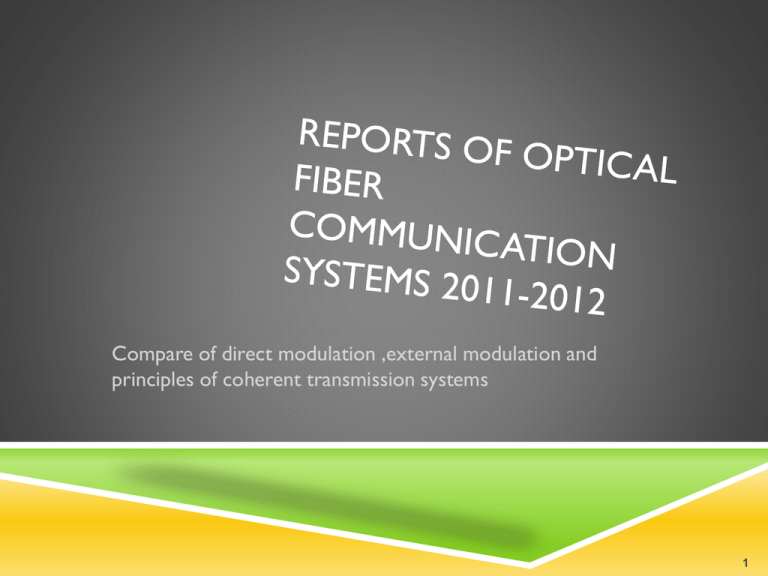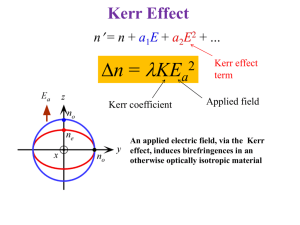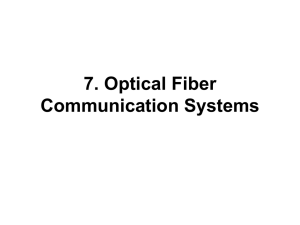Reports of optical fiber communication systems 2011-2012
advertisement

Compare of direct modulation ,external modulation and principles of coherent transmission systems 1 By: Sura Sa’ad 2 CONTENTS 1- Fiber optic communication 2- Advantage of Fiber optic communication 3- Optical Distributing and Generating 3-1 Direct Modulation 3-1-1 Advantages 3-1-2 Disadvantages 4- Modulation in communication systems 5- Optical modulator 6- Classification of optical modulators 7- External Modulators 3 1_FIBER OPTIC COMMUNICATION: Communication in which pulses light travels with its original speed i.e. 3*10^8 m/sec from one place to another with the help of optical fiber, and delay in speed occurs due to reflection ,refraction ,scattering ,dispersion ,macro bending ,macro bending and intermodal-dispersion.[1] 4 2_ADVANTAGE OF FIBER OPTIC COMMUNICATION: The biggest advantage is that communication is very quick since data travels with the speed of light [1] 5 3.OPTICAL DISTRIBUTING AND GENERATING: Several techniques for distributing and generating microwave signals via optical fiber exist.The techniques may be classified into two main categories namely Intensity– Direct Detection (IM-DD) and Remote Heterodyne Detection (RHD) techniques. The electrical signal at the Head end of the optical link may be one of three kinds namely, baseband, modulated IF, or the modulated RF signal itself. Whatever the case, the aim is to produce appropriate RF signals at the remote station, which meet the specifications of the wireless application.. 6 3-1 DIRECT MODULATION: The simplest method for optically distributing RF signals is simply to directly modulate the intensity of the light source with the RF signal itself and then to use direct detection at the photo detector to recover the RF signal. This method falls under the IM-DD technique [3]. There are two ways of modulating the light source. The laser diode can itself be modulated directly by using the appropriate RF signal to drive the laser bias current. The second option is to operate the laser in continuous wave (CW) mode and then use an external modulator such as the Mach-Zehnder Modulator (MZM), to modulate the intensity of the light. In both cases, the modulating signal is the actual RF signal to be distributed. The RF signal must be appropriately pre-modulated with data 7 3-1-1 ADVANTAGES The advantage of this method is that it is simple. Secondly, if low dispersion fiber is used together with a (linearized) external modulator, the system becomes linear. Consequently, the optical link acts only as an amplifier or attenuator and is therefore transparent to the modulation format of the RF signal 8 3-1-2 DISADVANTAGES: The disadvantage of this method depends on the fact that only low RF frequency signals can be generated (distributed). This is so because to generate higher frequency signals such as mm waves, the modulating signal must also be at the same high frequency. 9 3-1-2 DISADVANTAGES: A further disadvantage has to do with the fact that analogue applications are more sensitive to system non-linearity. As a result, linearity requirements of system components are more stringent in IMDD based RoF systems. For instance, drive amplifiers must compensate for incoherent static and dynamic non frequencies are involved. This leads to more complex systems.[4] 10 4_MODULATION IN COMMUNICATION SYSTEMS: Modulation is defined as a process by which any characteristics of a wave is varied as a function of the instantaneous value of another wave.The first wave which is a high frequency sine wave is known as carrier wave. Second wave is known as modulating wave and the resultant wave is known as the modulated wave. [1] 11 5_OPTICAL MODULATOR : An optical modulator is a device which is used to modulate a beam of light.The beam may be carried over free space, or propagated through an optical waveguide. Depending on the parameter of a light beam which is manipulated, modulators may be categorized into amplitude modulators, phase modulators, polarization modulators etc. Often the easiest way to obtain modulation of intensity of a light beam, is to modulate the current driving the light source, e.g. a laser diode.This sort of modulation is called direct modulation, as opposed to the external modulation performed by a light modulator. For this reason light modulators are, e.g. in fiber optic communications, called external light modulators. 12 5_OPTICAL MODULATOR : With laser diodes where narrow linewidth is required, direct modulation is avoided due to a high bandwidth "chirping" effect when applying and removing the current to the laser[2] 13 6_CLASSIFICATION OF OPTICAL MODULATORS: According to the properties of the material that are used to modulate the light beam, modulators are divided into two groups: absorptive modulators and refractive modulators. In absorption coefficient of the material is changed, in refractive modulators refractive index of the material is changed. The absorption coefficient of the material in the modulator can be manipulated by the Franz-Keldysh effect, the Quantum-confined Stark effect , excitonic absorption, or changes of free carrier concentration. Usually, if several such effects appear together, the modulator is called an electro-absorptive modulator. 14 7_EXTERNAL MODULATORS: When data rates were in the low gigabit range and transmission distances were less than 100 km or so, most fiber optic transmitters used directly modulated lasers. However, as data rates and span lengths grew, waveguide chirp, caused by turning a laser on and off, limited data rates. Dispersion problems resulted when the wavelength chirp widened the effective spectral width of the laser. A laser source with no wavelength chirp and a narrow linewidth provide one solution to the problem. This solution took the form of external modulation which allows the laser to be turned on continuously; the modulation is accomplished outside of the laser cavity. [4] 15 Thank you for listening 16











